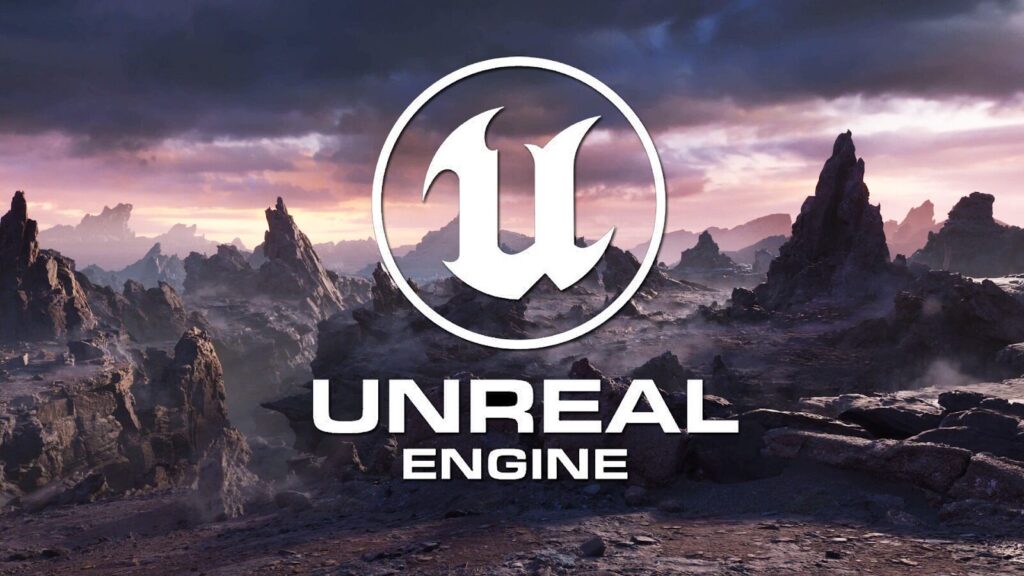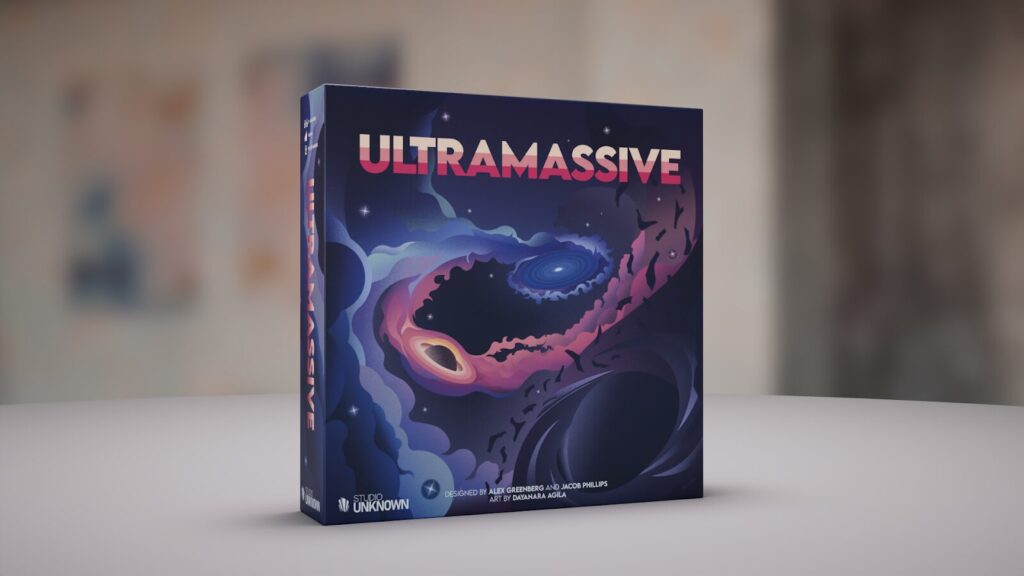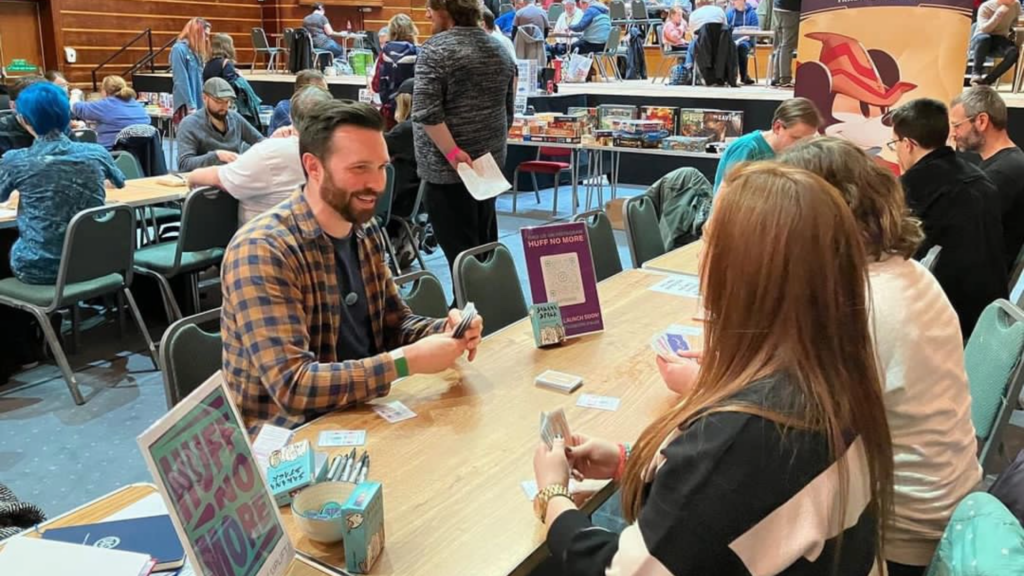This week on our blog, we’re diving deep into the indie publishing scene with Alex from Studio Unknown. Alex’s journey from a passionate gamer to the founder of his own game company is nothing short of inspiring. He shares his experiences navigating the challenging world of game development, emphasizing the pursuit of accessibility in the industry both for players and new developers. With the upcoming Kickstarter launch of his ambitious game, ULTRAMASSIVE, Alex reflects on challenges, strategies, and what it takes to succeed in an increasingly competitive market. Join us as we explore his story, insights, and the future he envisions for indie game development.
Joe: heya. Thanks for joining the blog. Can you tell me a little bit about yourself?
Alex: First and foremost, I’m a lifelong gamer. I grew up on Flash games and the Game Boy Advance. I studied games at university and graduated in 2020 with a BFA in game design. My professional career has been varied since graduating. I began with university research teams and freelance work, then moved to an architectural visualisation firm before founding my game company, Studio Unknown. For a year now, I have been running the studio full-time while working on ULTRAMASSIVE, our tableau/engine-building board game, alongside my co-designer and our artist.

Having navigated the game and digital art industries for about four years now, I’ve learned a lot about the realities of working in them—challenges and joys alike. I have spent considerable time reflecting on my initial expectations, particularly in the game industry. This reflection has led to a new mindset about working within the game industry. I am now chiefly concerned with accessibility, both fundamentally and ideologically, and I seize every opportunity to bridge the gap between players and developers, empowering that relationship. For me, making games and participating in the industry professionally is as much about creating good games as it is about driving change. That is my purpose with Studio Unknown.
Joe: The area of accessibility is really interesting, can you explore what you mean by that a little and what it looks like in your practice?
Alex: Accessibility means different things to different people. The most common understanding, in my experience, refers to making games playable for those who are physically or mentally impeded. This is a crucial topic in game design—I could discuss it at length—but I want to focus on a different aspect of accessibility that has been on my mind since starting my career. This one truly keeps me up at night.
Participating in the industry professionally is as much about creating good games as it is about driving change.
I am referring to accessibility for new game designers entering the gaming industry. Graduating with a degree in game design was immensely exciting for me and my colleagues. However, nothing diminishes that excitement like pouring countless hours into curating a portfolio, résumé, and personal pitch, only to be ignored en masse by game studios and related companies. I wish I could say that my experience was unique and that I simply didn’t understand how to attract the attention of the companies I aspired to work for. Unfortunately, even before graduating, I found myself surrounded by smart, creative people with identical experiences.
If you don’t believe me, you can learn about the widely recognised challenges of entering the gaming industry through numerous articles offering advice on the matter. The Indie Dev and Game Dev subreddits provide an especially grim outlook on the situation.
“the gaming industry is a highly competitive field —there are more applicants than there are vacancies. Moreover, some positions are harder to get into than others… If you want to get your foot in the door, cast your net as wide as you can. Attend events and reach out to recruitment agencies. Be open to taking on a role in an organisation even if it’s not your dream job and dream company. You’ll find it easier to join smaller companies.”
But what if even smaller companies won’t give you the time of day? How far removed from the gaming industry must you start your journey? How high, and for how long, must you climb before reaching the place where you hoped to start your career? And will you still have the drive and stamina to keep climbing once you get there? It’s exhausting to think about, let alone attempt.
Joe: That sounds incredibly daunting. How do you think the industry can better support aspiring designers to overcome these challenges?
Alex: The reality is that, due to the overwhelming, worldwide proliferation of the gaming industry, for every open position at a game studio, there are a hundred game developers ready to compete for it. Many of them may also be more skilled in your craft.
This sounds bleak for the multitude of aspiring game designers around the world. However, the good news is that the industry is changing. It has never been easier to design, produce, and sell your games with limited resources. For digital game designers, some of the most powerful design engines and software, such as Unreal Engine and Blender, are free to use. For tabletop designers, production capabilities like 3D printing are becoming cheaper and more accessible each year. Crowdfunding platforms like Gamefound are challenging Kickstarter’s dominance, offering alternative ways to fund your game’s development without having to compete with the perennial releases from industry giants like Asmodee, Exploding Kittens, and Unstable Games.
This kind of accessibility makes me hopeful for the future of the industry. There is real power in having the tools to simply say, “I’ll do it myself.”

I encourage those new to game design to carefully consider their approach to the industry. Climbing the corporate ladder suits some people, but for many others, independent development, freelance work, and self-publishing can offer a plethora of opportunities. Plus, you will learn a lot from these practices.
This kind of accessibility makes me hopeful for the future of the industry. There is real power in having the tools to simply say, “I’ll do it myself.”
That said, there is still much to do to push the industry further towards accessibility. Studios and designers with power and influence must play a part in maintaining momentum towards a healthy, inspired, indie-driven industry. A significant part of this involves developing a closer relationship with players and communities. Developers must listen to player input and make it clear that they’ve been heard. Game design is a collaborative practice, not just among designers but also between designers and players. By maintaining strong communication and appreciation between these groups, we can pave the way for new ideas and real innovation, in ways we have only just begun to see.
I am incredibly excited about championing this approach with Studio Unknown. I believe we can change the accessibility of the gaming industry on a foundational level.
Joe: I’ve had a few discussions recently with people who feel that those big studios are now swamping the Kickstarter market too. Making it harder for indies to self-publish, do you see this in the model you describe above, is it getting harder or easier from your experience?
Alex: That’s a good counterpoint to what I’ve mentioned about independent development. To some degree, I agree about the influence of large publishers saturating and commandeering crowdfunding platforms. This is an interesting point to consider from several angles. On one hand, we can’t fault those publishers for taking advantage of the platforms available to them. On the other hand, when Allplay Games raises $600k+ for a new Kabuto Sumo game, smaller projects on the fringes are pushed out of the spotlight and likely remain unfunded. However, we do still see small and independent publishers succeeding on Kickstarter. Kinson Key Games made nearly a million dollars with Galactic Cruise earlier this year, and First Fish Games made over $300k with Mistwind last year. These aren’t isolated examples, either.
What do we make of all this? I don’t think large publishers using crowdfunding platforms signal the end of the line for indie studios. A somewhat analogous situation in the digital game world is indie development on Steam. The most popular video games in the world are regularly released on Steam, yet the indie scene on that platform is flourishing. This is, in part, due to its early access feature, designed to provide creators with funding to continue development and ideally complete their games—much like Kickstarter. The difference here is that while video games were already an enormous, exponentially growing industry before Steam’s early access feature, Kickstarter played a significant role in the rise of board game popularity in the last decade. It set a different precedent. Board gamers and designers alike frequently look to Kickstarter (and now Gamefound) for noteworthy upcoming releases, so it makes sense for publishers, both big and small, to flock to it.
I wish I had an easy answer, but the reality is that much of the directive falls on the shoulders of the crowdfunding platforms. Kickstarter doesn’t always need to add the “Project We Love” label—a substantial boost in visibility for any project—to games by behemoth publishers, but they do. Gamefound has shown promise as an alternative to Kickstarter, but when Awaken Realms (the creators of Gamefound) launches their own game, Grimcoven, which raises three million dollars on the platform, it loses some appeal for smaller studios. It’s a tricky situation for indie developers.
Joe: I think this all makes it a challenging but also interesting place to explore for our game. With the above in mind, what are your plans for launching ULTRAMASSIVE?
Alex: We are launching ULTRAMASSIVE on Kickstarter in early October. Despite the challenges, particularly the intense competition, Kickstarter makes publishing as an indie studio accessible—especially for our first release. At the end of the day, building a community around your game and studio can still lead to success through crowdfunding. That’s why I emphasise communication with players so much. You don’t need thousands of backers to bring your game to life; you just need enough people who trust you, believe in you, and like what you create. Engaging with your community regularly and in a genuine manner is a powerful way of achieving that.
You don’t need thousands of backers to bring your game to life; you just need enough people who trust you, believe in you, and like what you create.
Make your players feel heard and seen. Give them insight into your process by pulling back the curtain and sharing your experiences. This way, it’s not just a numbers game, and you aren’t just a name on a game box—you become a person. That’s what I’ve tried to do with ULTRAMASSIVE and Studio Unknown. I want to show people who I am and what my values are—that I take game design as seriously as I take the community that faithfully supports it.

Joe: I’m fully behind this. As I’m watching a lot of Kickstarters carefully, I feel like I can quite reliably spot those that are going to do well and those that will struggle.
It’s not just number of followers (as you say) but the rest of the project and how that’s been communicated. The whole business of choosing when to launch isn’t an exact science though – so regarding ULTRAMASSIVE, what does your road map to launch look like, how will you know when you’re ready?
Alex: Great question. I think there may never be a perfect moment when we’re “ready.” Much like actually designing a game, preparations for the launch could go on indefinitely. We have our launch date picked out; ULTRAMASSIVE’s Kickstarter page is almost complete; our last convention is right around the corner, and our content creation partners are working on their ULTRAMASSIVE previews, videos, blogs, and so on as we speak. There isn’t much left for us to do… except for all the little tweaks, detail adjustments, and final touches that I’d like to keep making forever. At some point, though, you have to take a step back and remember that everyone is not in your head with you. Many of those tweaks and perfections I want to make may have no impact on how people perceive ULTRAMASSIVE and its campaign—it’s entirely possible no one will even notice those things.
It’s not about knowing exactly when you’re ready. I think the moment you recognize that it’s not about you is when you can let go of perfectionism and focus on delivering the game and experience that people want. I’ve spent enough time reconciling with all of that to say that the game—what’s important—is ready. The campaign and supporting elements are almost ready. When those things are in harmony, we’ll launch ULTRAMASSIVE. Personally, I may never feel completely ready, and that’s okay.
Joe: that gets us to game is ready – how about audience building. I’m watching kickstarters carefully and so many people throw themselves into a live campaign with not enough support. Inevitably and sadly they don’t succeed.
Two questions – why do you think that is, where does that rush to launch come from? And second, how are you making sure that doesn’t happen for ULTRAMASSIVE?
Alex: Launching prematurely is easy to do. There are many factors that contribute to a premature launch, but I’ve observed (and experienced) three main reasons.
First, there’s a lack of resources. It takes a lot of time, effort, and especially money to properly prepare for a board game launch. Social media is one of the few free audience-building tools, but it’s only a small piece of the pie. The most effective methods—conventions, working with creators for previews, and paid advertising campaigns—cost a lot. Getting deep into the development process and then running out of money not only feels terrible, it also leaves developers with two unpleasant choices: launch prematurely or shelve the project until they have more resources. At least one of those options offers some sense of finality to what was likely an arduous process.
Second, there’s plain eagerness. I’ve felt this during the ULTRAMASSIVE project. It’s hard to put months or years into a project, reach a point where everything looks and feels great, and then still have to wait to launch what you already believe is a fantastic product. Needless to say, you still need hundreds of others to believe it too.
The final, and I believe the biggest, reason for premature launches is not being aware of all the audience-building methods and how to navigate them effectively. Numerous tasks are embedded within promotional methods like conventions, ad campaigns, and previews. Each requires art assets, a detailed execution plan, outreach, budgeting, coordination—the list goes on. On top of all that, you have to figure out how to stand out among myriad other projects doing the same things. Predicting and planning for all of that without prior experience or a guiding hand is nearly impossible.

For ULTRAMASSIVE, we have relied on one increasingly important practice: flexibility. Many times, we thought we were ready to launch, only to discover we didn’t have enough people on our mailing list, needed more preview content, or had a subpar advertising plan. With each newly realised audience-building method, we spent days researching and reaching out to more experienced individuals, gathering as much information as possible. We identified how much time we needed to spend on each method, then folded it into our project timeline, reevaluated our budget, and adjusted our priorities accordingly.
The most difficult part was pushing the launch date back by months each time, especially after publicly announcing it. We’ve been fortunate to have the resources to afford this kind of flexibility. Without it, I wouldn’t have been confident in our odds of a successful campaign.
Joe: Really interesting points Alex, hopefully this insight will slow some designers down a little. To finish off, can you tell us a bit more about ULTRAMASSIVE?
Alex: Gladly! The elevator pitch is that it’s an engine-building game where you play as a black hole. Your objective: consume more Matter and Antimatter than your opponents to become the largest black hole in existence. Its key features include a robust and diverse tech tree, a lot of freedom in how players take actions and conduct their turns, and simultaneous turns. We leaned heavily into the engine/tableau-building aspect of the game, providing players with many options for structuring their turns. For those who enjoy optimization, ULTRAMASSIVE scratches a deep itch (I would know—I’m big into optimization).
For us, ULTRAMASSIVE is our first foray into board game development and publishing. Two years ago, on October 2nd, I started this game in my free time after watching a fascinating YouTube video by Kurzgesagt about black holes. I had no idea what an incredible path it would lead me down. I have had the wonderful opportunity to create the game I would want to play—the game that would catch my eye, draw me in, and occupy space on my shelf for a long time.
It’s a special experience. So, on top of being our first game production, ULTRAMASSIVE is the culmination of a lot of passion, dreams, and life experience for me.
ULTRAMASSIVE launches on Kickstarter on October 2nd, 2024. Time to find out if I’m right about this game being more than just my cup of tea.
Thanks to Alex for his insight this week. You can find Studio Unknown on Instagram, and follow the kickstarter at the link above.
Remember to sign up below to get the blog straight to your emails…


